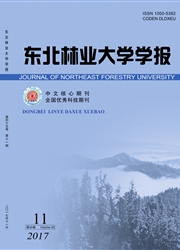

 中文摘要:
中文摘要:
以浙江省安吉县毛竹林为研究对象,测定毛竹快速生长时期的竹笋高生长及其地上生物量,并利用涡度相关技术测定毛竹林生态系统的CO2通量。结果表明:竹笋高生长遵循“慢-快-慢”的生长规律,在出笋18 d左右达到最大值,约为0.78 m/d;区域平均立竹度为0.43株/m2,在毛竹地上构件中,竹秆、竹枝、竹叶的平均生物量分别为1.89、0.16、0.06 kg/m2,地上部分平均生物量为2.11 kg/m2。3—6月份的CO2通量是负值,毛竹林为碳汇阶段,其中4月份的CO2通量绝对值最大,绝对均值为0.073 mg· m^-2· s^-1,5月份CO2通量较3月份、4月低,日均CO2通量呈“U”形变化;竹笋日均高生长量与碳通量呈极显著负相关(P<0.01),与空气温度、土壤温度、土壤含水量呈极显著正相关( P<0.01),与空气相对湿度、净辐射、风速相关性不强。
 英文摘要:
英文摘要:
We measured moso bamboo ( Phyllostachys edulis) shoots growth and biomass in its rapid growth stage ( from March to June) and got the data of carbon flux in the above period from flux tower .Bamboo shoots high growth follows the “S” type, with its peak at around 18 d, at about 0.78 m/d.The average density of bamboo stand is 0.43strain /m2 .The monthly aver-age biomass above ground and underground are 2.11 and 2.59 kg/m2, respectively.Among the constituents of moso bamboo above ground , the biomass in stem is the biggest , the next is branches and the least is in leaf .CO2 flux data was negative from March to June, and the absolute mean in April was highest , the number is 0.072 72 mg· m^-2· s^-1.CO2 flux data in May was the lowest in these four months ,and the average daily CO 2 flux data forms a“ U” shape.The daily high growth of bamboo shoots has significantly negative correlation with carbon flux , significant positive correlation with air temperature and soil temperature, soil moisture content.However, it has little correlation with air humidity, net radiation and wind speed.
 同期刊论文项目
同期刊论文项目
 同项目期刊论文
同项目期刊论文
 期刊信息
期刊信息
